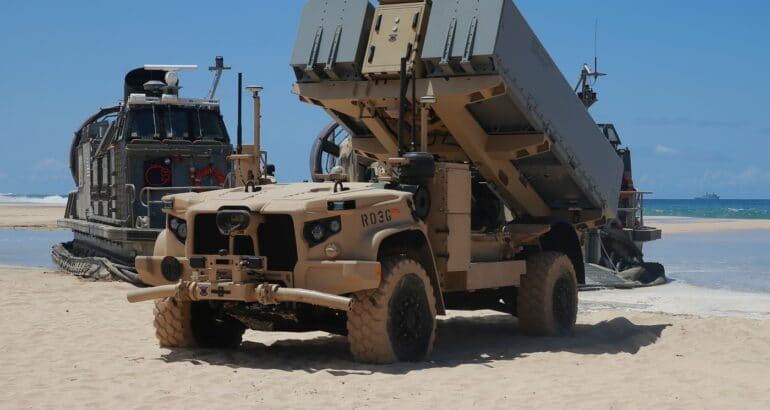
A Navy Marine Expeditionary Ship Interdiction System launcher deploys into position aboard Pacific Missile Range Facility Barking Sands, Hawaii, Aug. 16, 2021. The NMESIS and its Naval Strike Missiles participated in a live-fire exercise, here, part of Large Scale Exercise 2021. During the training, a Marine Corps fires expeditionary advanced base sensed, located, identified and struck a target ship at sea, which required more than 100 nautical miles of missile flight. The fires EAB Marines developed a targeting solution for a joint force of seapower and airpower which struck the ship as the Marines displaced to a new firing position. The Marine Corps EABO concept is a core component of the Force Design 2030 modernization effort. (U.S. Marine Corps photo by Maj. Nick Mannweiler, released)
Marine Corps Successfully Demonstrates NMESIS During LSE 21
The Navy/Marine Corps Expeditionary Ship Interdiction System (NMESIS) successfully hit its target in support of Marine Corps Forces, Pacific, during Large Scale Exercise 21 Aug. 15, 2021. The exercise showcased the U.S. maritime forces’ ability to deliver lethal, integrated all-domain naval power.
Xavier Vavasseur 18 Aug 2021Story by Kelly Flynn, Marine Corps Systems Command
LSE 21 was a live, virtual and constructive scenario-driven, globally-integrated exercise with activities spanning 17 time zones. LSE 21 applied and assessed developmental warfighting concepts that will define how the future Navy and Marine Corps compete, respond to crises, fight and win in conflict.
The Marine Corps’ NMESIS will provide the Marine Littoral Regiment with ground based anti-ship capability to facilitate sea denial and control while persisting within the enemy’s weapons engagement-zone, and LSE 21 provided a venue for the program team to validate some of those concepts.
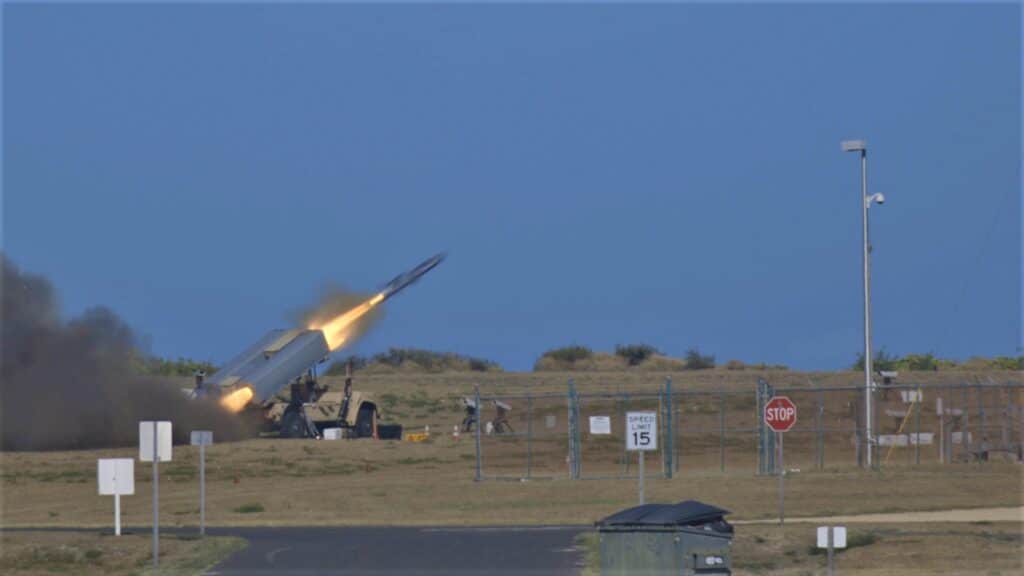
A Naval Strike Missile streaks out to sea before striking a naval target ship, Aug. 15, 2021, aboard Pacific Missile Range Facility Barking Sands, Hawaii. The missile flew more than 100 nautical miles before finding its mark. The live-fire sinking exercise demonstrated a Marine fires expeditionary advanced base’s ability to sense, target and strike a target at sea, providing sea control or contributing to sea denial in fleet operations. The Marine Corps’ Force Design 2030 centers on Marines providing long-range precision strike capabilities as a stand-in force during littoral operations in a contested environment. (U.S. Marine Corps photo by Lance Cpl. Dillon Buck, released)
SINKEX, the exercise scenario involving NMESIS, provided a testing environment for new and developing technologies to connect, locate, identify, target and destroy adversary threats in all domains, culminating in the live-fire demonstration of the naval strike missile against a sea-based target. During the exercise, forward-deployed forces on expeditionary advanced bases detected and, after joint command and control collaboration with other U.S. forces, responded to a ship-based adversary. Simultaneous impacts from multiple, dispersed weapons systems and platforms across different U.S. services—including NMESIS—engaged the threat.“This scenario is representative of the real-world challenges and missions the Navy and Marine Corps will be facing together in the future. This exercise also provided an opportunity for us to work alongside our service partners to refine Force Design 2030 modernization concepts.”
Brig. Gen. A.J. Pasagian, commander of Marine Corps Systems Command.

Artillery Marines from 1st Battalion, 12th Marines provide security as a Marine KC-130J loadmaster deploys a Navy Marine Expeditionary Ship Interdiction System launcher aboard Pacific Missile Range Facility Barking Sands, Hawaii, Aug. 15, 2021. After striking a naval target ship with two Naval Strike Missiles flying 100 nautical miles, 1/12 rehearsed tactical displacement and relocation. A key component of the Marine Corps’ Force Design 2030, expeditionary advanced base operations include low-signature, dispersed teams of Marines holding a potential adversary’s ships at risk from long-range precision strike weapons, providing sea control and contributing to sea denial in support of the Fleet. The training, part of Large Scale Exercise 2021, allowed Marines to refine support to distributed maritime operations by providing expeditionary advanced base operations and littoral operations in a contested environment. (U.S. Marine Corps photo by Cpl. Luke Cohen, released)
NMESIS integrates established, proven sub-systems, such as the Joint Lightweight Tactical Vehicle Chassis, the Naval Strike Missile and the Fire Control System used by the Navy for NSM.
“From an acquisition perspective, NMESIS started a little over two years ago. We’ve been able to rapidly move [on developing and fielding this system] because we’re leveraging existing NSM and JLTV subsystems.”
Joe McPherson, long range fires program manager at MCSC
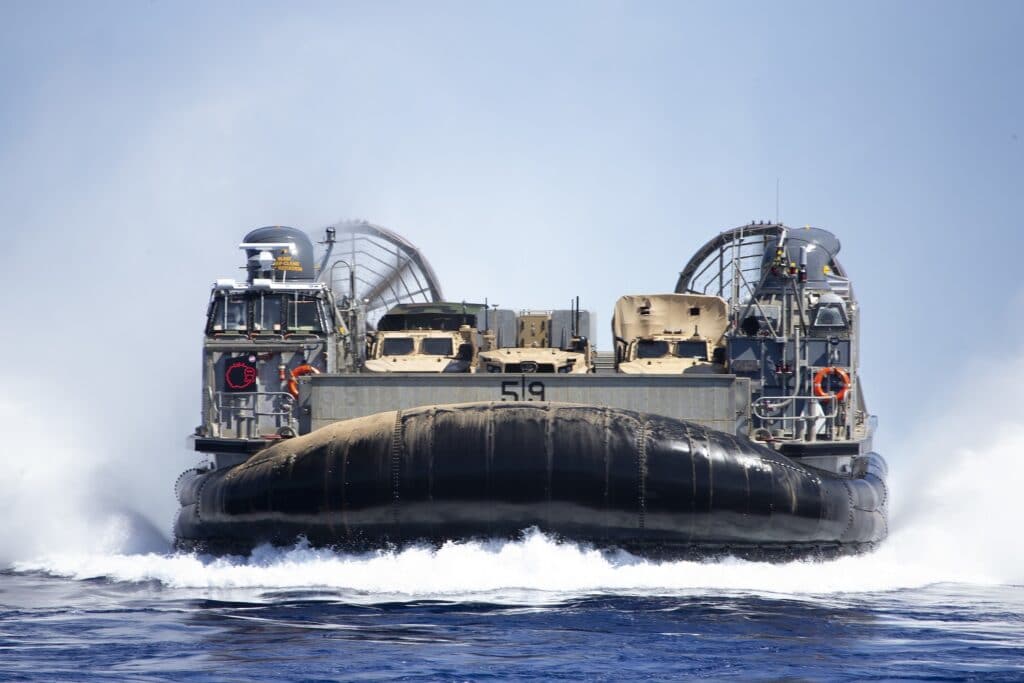
A Navy Marine Expeditionary Ship Interdiction System launcher, a command and control vehicle and a Joint Light Tactical Vehicle are transported by a U.S. Navy Landing Craft Air Cushion from Pacific Missile Range Facility Barking Sands, Hawaii, out to U.S.S. San Diego, Aug. 16, 2021. The movement demonstrated the mobility of a Marine Corps fires expeditionary advanced base, a core concept in the Marine Corps’ Force Design 2030 efforts. U.S. Navy and Marine Corps units came together from across 17 time zones as they participated in Large Scale Exercise 2021. (U.S. Marine Corps photo by Cpl. Luke Cohen, released)
Because NMESIS is not yet a fielded capability, engineers from MCSC managed the fire control piece of the system during the exercise. Marines, however, were able to practice maneuvering the system and validating the system’s interoperability with their Naval and Air Force partners.
“This week was very successful,” said McPherson. “In addition to the two live fire shots that hit the target, we also successfully deployed the system aboard the Marine Corps’ primary transport systems, the C130 and LCAC.”
Though not associated with its program development, the NMESIS transportability and mobility demonstration serves an important role in developing tactics, techniques and procedures related to this critical capability, said McPherson.
MCSC is developing and fielding new anti-surface warfare weapons capabilities, including NMESIS, on pace to support Force Design 2030 objectives. These new capabilities contribute to the Fleet’s ability to achieve sea control, sea denial and defense against adversary amphibious force missions.
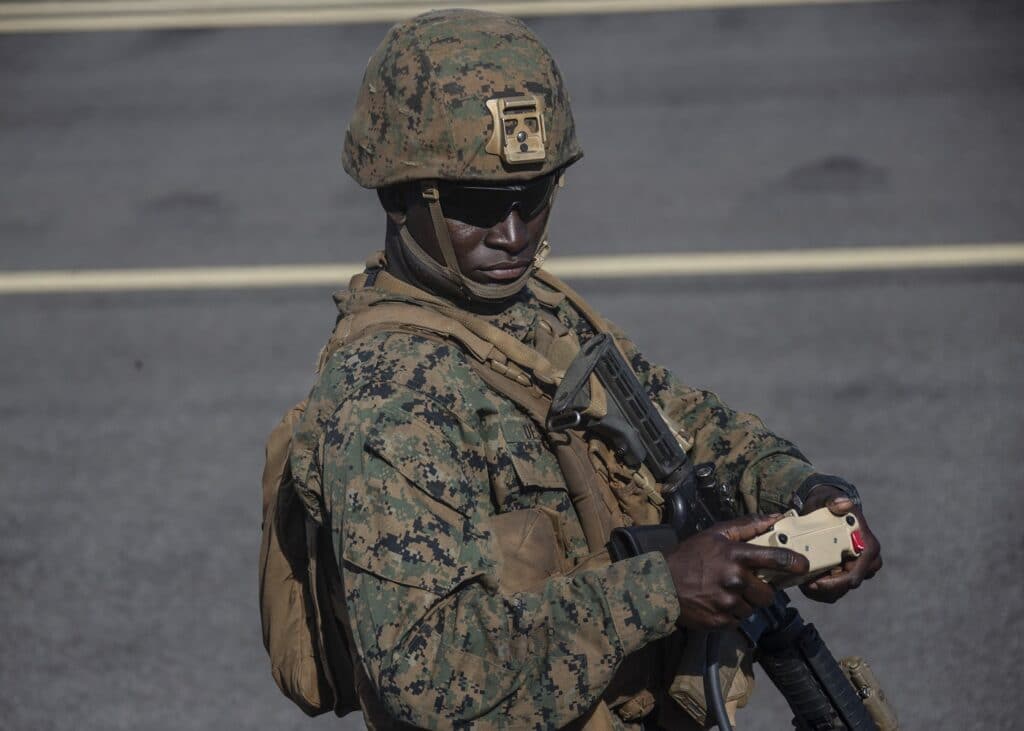
Pfc. Guerby Destine, 22, number two cannon cocker with 1st Battalion, 12th Marines and a Westbury, N.Y., native, drives a Navy Marine Expeditionary Ship Interdiction System launcher aboard Pacific Missile Range Facility Barking Sands, Hawaii, Aug. 15, 2021. The Marines of 1/12 struck a naval target ship with two Naval Strike Missiles after sensing and targeting the vessel from their fires expeditionary advanced base while participating in Large Scale Exercise 2021. The exercise allowed Marines to support distributed maritime operations by providing expeditionary advanced base operations and littoral operations in a contested environment. More than 25,000 Marines and sailors took part in LSE 2021 from five numbered fleets and all three Marine Expeditionary Forces. (U.S. Marine Corps photo by Cpl. Luke Cohen, released)
Exercises such as LSE 21 increase maritime interoperability and the ability to project American power at home and around the world.“This exercise gave us an opportunity to not only measure, but also validate the concepts for [the Marine Corps’] anti-ship capability, which is one of the most important avenues of the Commandant’s Force Design 2030. I think the successful launches of the missile will help us clarify the path forward as we move to fulfill the Commandant’s 2030 vision, and giving the Marine Corps a transformative anti-ship capability.”
Lieutenant Col. Ryan Collins, combat integration office for artillery and fires at Marine Corps Combat Development Directorate, Combat Development and Integration.
-End-
About NMESIS

A Navy Marine Expeditionary Ship Interdiction System launcher vehicle deploys into position aboard Pacific Missile Range (U.S. Marine Corps photo by Cpl. Luke Cohen, released)A Navy Marine Expeditionary Ship Interdiction System launcher vehicle deploys into position aboard Pacific Missile Range (U.S. Marine Corps photo by Cpl. Luke Cohen, releasedAn artillery Marine from 1st Battalion, 12th Marines maneuvers a Navy Marine Expeditionary Ship Interdiction System launcher across the beach aboard Pacific Missile Range Facility Barking Sands, Hawaii, Aug. 16, 2021. During Large Scale Exercise 2021, the Marines of 1/12 struck a naval target ship with two Naval Strike Missiles which flew more than 100 nautical miles before striking the ship. LSE 2021 allowed Marines to refine concepts such as expeditionary advanced base operations and littoral operations in a contested environment in order to provide sea control or contribute to sea denial near key maritime terrain. (U.S. Marine Corps photo by Cpl. Luke Cohen, released)
NMESIS combines the NSM anti-ship missile with a Remotely Operated Ground Unit for Expeditionary (ROGUE) Fires vehicle, produced by Oshkosh Defense
NSM is a multi-mission cruise missile designed to destroy heavily defended maritime and land targets; it is the U.S. Navy’s over-the-horizon weapon system for littoral combat ships and future frigate
As we reported previously, the USMC selection of Naval Strike Missiles from Raytheon was first announced in May 2019. The image released today confirms that the USMC uses an unmanned variant of the Joint Light Tactical Vehicle (JLTV) known as “ROGUE Fires”, as the NSM launch platform. The same vehicles is used for rockets:
The NMESIS was test fired for the first time during a “November 2020 live fire event “ which we first mentioned back in February 2021.
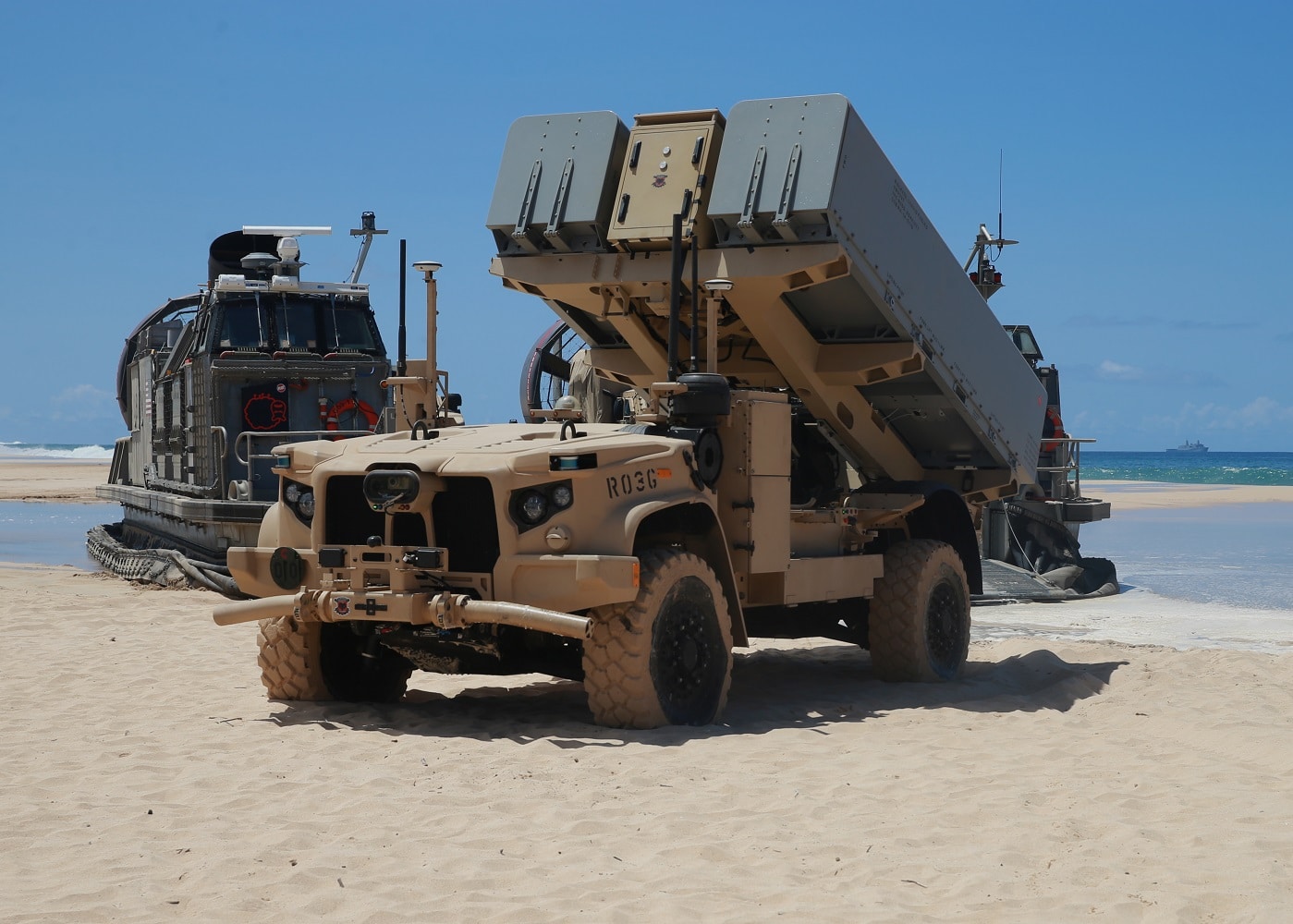
Marine Corps successfully demonstrates NMESIS during LSE 21 - Naval News
The Navy/Marine Corps Expeditionary Ship Interdiction System (NMESIS) successfully hit its target in support of Marine Corps Forces, Pacific, during Large Scale Exercise (LSE) 21 Aug. 15, 2021...



